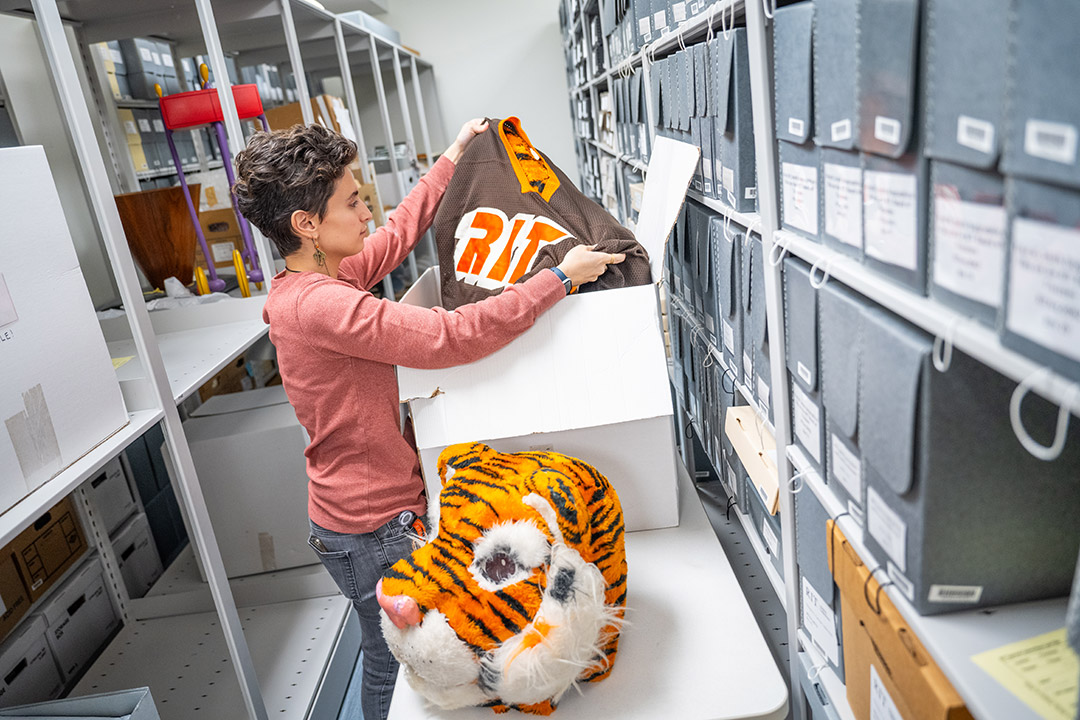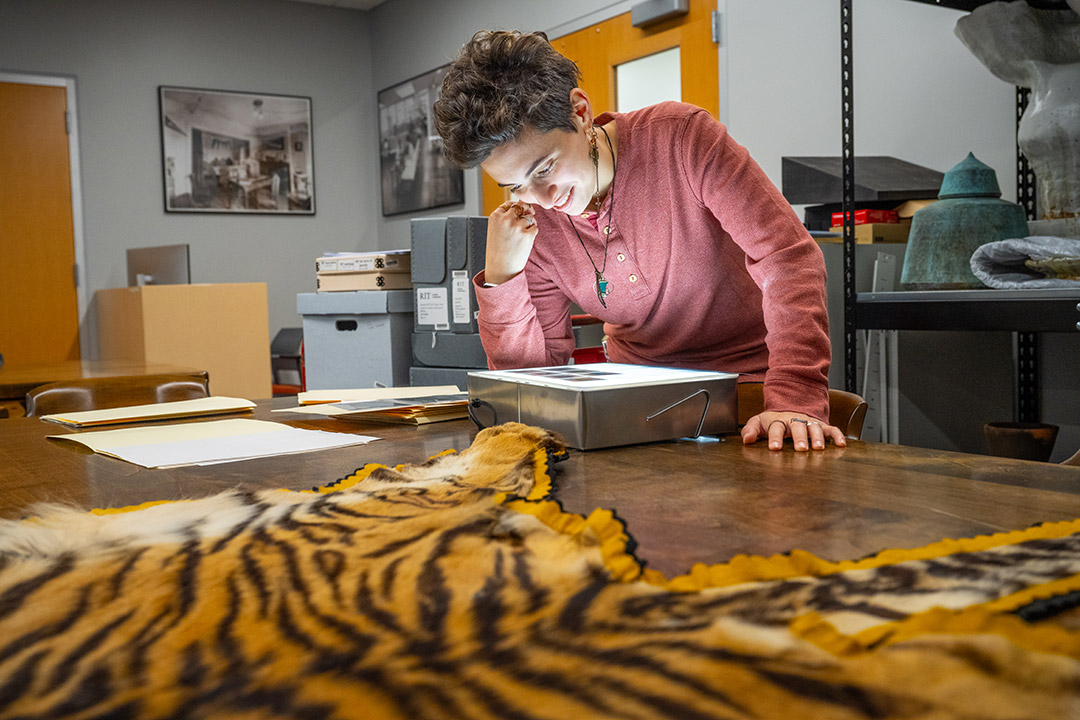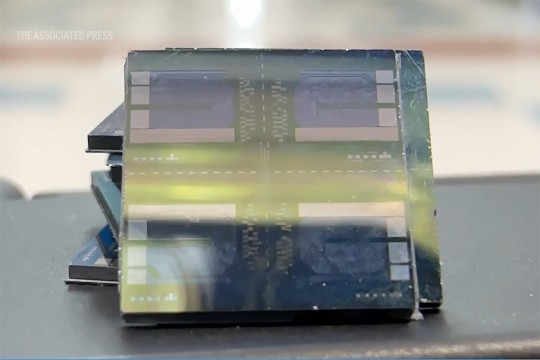Students find tiger pride in the RIT Archives
Traci Westcott/RIT
When Ritchie needs a new look, the old costume is retired to the RIT Archives. Here, Nic Feldman, a museum studies major, unboxes the affectionately known “Grandpa Ritchie.” The paper mâché tiger head will be on display in the exhibit “The Stories They Tell: S.P.I.R.I.T.”
A student-curated exhibit highlighting RIT tiger pride will be on display outside the RIT Archives in time for Brick City Homecoming and Family Weekend, Oct. 18-20.
Students in the museum studies course, Critical and Digital Curation, used the archives to explore the origin of the RIT tiger mascot in 1955. Their exhibit, “The Stories They Tell: S.P.I.R.I.T,” shines a light on 1963, when RIT students brought a tiger cub to campus, parties, and hockey games. They named him “SPIRIT” for “Student Pride In RIT.”
Traci Westcott/RIT
Nic Feldman uses a light box to look at slides of the RIT tiger cub, SPIRIT, from 1963. A medical condition caused the cub to be euthanized in 1964. His pelt, seen in the foreground, is kept in the RIT Archives.
Behind the exhibit itself is the experience students gained by partnering with the RIT Archives to explore and share the university’s unique history.
Nic Feldman, a fourth-year museum studies major from Alexandria, Va., and their classmates spent hours in the archives conducting research for the “S.P.I.R.I.T.” exhibit and going through boxes containing documents, photographs, ephemera, and other items showing school pride.
The exhibit will include examples of “Tiger Stock,” certificates, which students sold to purchase the tiger cub, and several photographs of SPIRIT himself. In one picture, a student handler holding the cub is dressed in an early Ritchie mascot. Ritchie pre-dated SPIRIT, and the mascot’s evolution will be showcased through costumes, a hockey jersey, Ritchie-themed stress toys, and more.
A small-scale replica will represent the bronze tiger in the Kodak Quad. The original sweater a student made for the tiger one winter also will be on display. A graduate student known only as “Stevie” knitted the orange sweater with brown “RIT” lettering (RIT’s former colors), and unwittingly started a tradition.
The “S.P.I.R.I.T.” exhibit illustrates how the RIT Archives enhances students’ education and lends context to classroom curriculum. RIT’s University Archivist Elizabeth Call envisions student-created displays and exhibits in common spaces throughout campus that draw attention to the university’s history.
“It’s giving students this incredible experience of being able to go into the archives and curate something and have everybody be able to learn from and enjoy it,” Call said. “Visualizing RIT’s legacy builds pride and curiosity.”
Call looks to the permanent exhibit in the “history hallway” in Liberal Arts Hall as a model for forming collaborative teams of student researchers and designers to share stories from the RIT Archives. Funding from the College of Liberal Arts and the history department supported the project.
The student exhibit, “Beyond The Needle: The Impact of the Domestic Science Program on RIT,” adds interest to the history hallway with a timeline and vignettes that trace the legacy of the domestic science program offered in 1893 at the Mechanics Institute, RIT’s forerunner.
The project grew from the class, Hands on History: Examining RIT’s Domestic Science and Arts Program, that Call taught last fall from the RIT Archives. She asked students Milena Kahan, a second-year criminal, justice and history double major from Davis, Calif., and Riley Mason, a fourth-year museum studies major from Mililani, Hawaii, to extend what they learned into a visual display.
Mason and Kahan pored over letters, coursework, class brochures, and ledgers to follow leads that sometimes resulted in useful narratives and other times, dead ends.
“It was a lot of creative thinking and hypothesizing, and basically working backwards to build a bigger picture,” Mason said.
Invited to join the team, Michael Grippo, a fourth-year graphic design major from Airmont, N.Y., visualized the narrative Kahan and Mason built from the collection. Grippo looked at more than 80 years of RIT yearbooks to gain inspiration. Handling the original objects influenced his overall design.
A new group of students taking Call’s Hands on History class this semester are learning about the Urbanarium: Project Ideas for Greater Rochester. The RIT-affiliated program from the 1970s sought to address urban issues through community projects. Students are exploring the Urbanarium collections held at RIT and on loan from the Rochester Public Library. They also viewed the 1968 documentary, Think About It, addressing Rochester’s housing crisis from nearly 60 years ago.
A collaboration of students from museum studies and graphic design classes worked together during the previous academic year to create the exhibit, “City of Contrast/Campus of Contrast: Revisiting 150 years of Artistic Achievement at RIT,” now on display on Wallace Library’s third floor. Students from the Art, Design, and Exhibition course, held last fall, developed the concept of a retrospective of the RIT 150th Anniversary Art Show collection. They shared their ideas with peers in the Experiential Graphic Design class, offered last spring, who visualized the concepts. The original exhibit—curated by former College of Art and Design dean Stanley Whitmeyer—featured artwork created by RIT students and faculty between 1891 and 1979.
“I love the idea of students dipping into work that was curated by a dean,” Call said. “It’s one example of people experiencing the legacy of RIT while they’re students in an experiential way that I think is truly unique.”
For Feldman, hands-on experience in the RIT Archives has translated into marketable skills, such as curating exhibits, digitizing objects, and documenting the condition of pieces in the collection. The archives is a second home for Feldman, where they spend time working on class projects and as a student employee.
“With my work in archives, I’ve got three exhibits under my belt, I attended a rare book conference, and I was a TA for a day for a museum studies class,” Feldman said. “In general, I’ve had a lot of different experiences that have absolutely prepared me for the professional world.”
Nic Feldman stands next to an outfit worn by Cheap Trick’s lead singer Robin Zander.
From the RIT Archives to an internship at the Rock & Roll Hall of Fame, RIT student Nic Feldman has found the career path that makes them sing.
Their experience as an RIT museum studies major and RIT Archives student employee helped them secure a prized internship in Cleveland last summer.
Feldman, from Alexandria, Va., worked in the Rock & Roll Hall of Fame’s collections department. They learned to assess objects and create condition reports using a pair of Freddy Mercury’s Adidas sneakers that had just arrived on loan. Feldman documented the condition of the sneakers worn by Queen’s lead singer to track any damage and conservation needs.
Other notable items Feldman handled included the red jacket Michael Jackson wore in the “Thriller” video (“It was surprisingly heavy.”) and a 2006 replica of Eddie VanHalen’s Frankenstein guitar (“He built the original himself.”)
Feldman also had the opportunity to look at one of Bruce Springsteen’s lyric books containing verses from “Glory Days” and “Born in the USA.” (“I’m a big Springsteen fan.”) Many of the objects they assessed are in the exhibit “1984: Pop Music’s Best Year Ever.”
The internship confirmed Feldman’s plans to pursue a career in collections management or exhibitions. It also underscored the knowledge and experience they gained at RIT on their path to Cleveland, where they hope to return. “My dream is to go back to the Rock Hall,” Feldman said. “I loved it there.”














